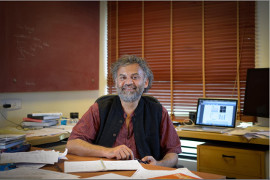Prof. Madan Rao
THEORETICAL APPROACHES IN CELL AND TISSUE BIOLOGY
PHYSICS OF ACTIVE, EVOLVING SYSTEMS
A large part of our effort is in exploring new physical and chemical principles underlying biological organization across scales, from functional biomolecules, to subcellular organelles, to the cellular and tissue scale. We are interested in the folding and packaging principles that govern the three dimensional functional organization of large biomolecular assemblies, such as proteins and chromatin, and their interactions with other cellular components. At a larger scale, at the subcellular, cellular and tissue level, organization is often driven by active mechanisms fuelled by energy. In many cases, such actively driven organization enables the efficient processing of information, computation and control - tasks that a self-organized living machine has evolved to perform.
Typically these active forces arise from (i) the coupled dynamics of the cytoskeleton, motors and cytoskeletal regulatory proteins, and (ii) the active dynamics of fission and fusion of organelles, and regulate the flux of mass, stress, energy and information. We have been engaged in developing a theoretical framework, called active hydrodynamics, to address situations where activity plays a significant role. Using this framework we study the mechanical response, pattern formation, symmetry breaking, hydrodynamic instabilities and information flows in both in-vivo and in-vitro reconstituted active systems.
Specifically we have been working on (details on next page)
- Active Organization and Dynamics of molecules at the cell surface : Active Composite Cell Surface
- Shape dynamics in membranes coupled to the active cytoskeleton : Active Composite Cell Surface
- Golgi and Mitochondrial morphogenesis and remodeling
- Chromatin organization and active mechanics in the Nucleus
- Actomyosin dynamics and Cytokinesis in Fission Yeast
- Tissue Dynamics, Developmental Patterning, Collective Cell Migration
- Information processing & Computation in Cells
- Mechanisms of Homeostatic Control in Cells and Tissues
- Non-equilibirum Self Assembly constrained by function
- Physics of Soft Active Matter
- Dynamics of folding, aggregation and chemical reactions of biomolecules
In addition, I have other research interests (though regrettably I seem to be having less time for these)
(i) Nonequilibrium phenomena in solids : Driven Elastic Media, Non-affine deformations in solids under shear, Onset of Plasticity
(ii) Nonequilibrium Soft Matter Physics : Dynamics of ordering transitions on membranes and shape changes, Soft rheology, Statistical Mechanics of biomolecules
(iii) Nonequilibrium statistical mechanics of driven interacting systems



